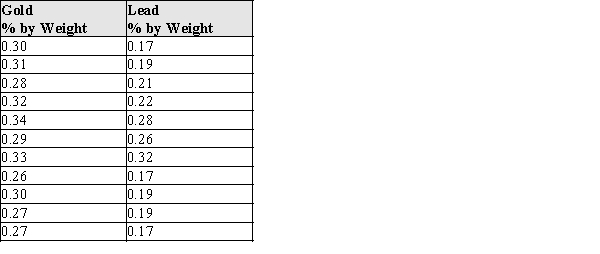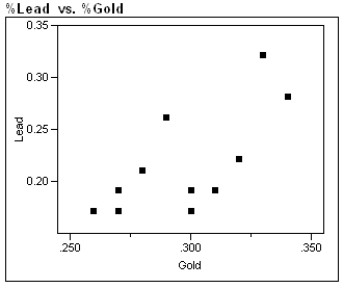Exhibit 4-5
During the first 3 centuries AD, the Roman Empire produced coins in the Eastern provinces. Some historians argue that not all these coins were produced in local mints, and further that the mint of Rome struck some of them. Because the "style" of coins is difficult to analyze, the historians would like to use metallurgical analysis as one tool to identify the source mints of these coins. Investigators studied 11 coins known to have been produced by local mints in an attempt to identify a trace element profile for these coins, and have identified gold and lead as possible factors in identifying other coins as having been locally minted. The gold and lead content, measured as a % of weight of each coin, is given in the table, and a scatter plot of these data is presented below. 

-Refer to Exhibit 4-5.
a)What is the equation of the least squares best fit line?
b)Sketch the best fit line on the scatter plot.
c)What is the value of the correlation coefficient? Interpret this value.
d)What is the value of the coefficient of determination? Give an interpretation of this value.
Correct Answer:
Verified
View Answer
Unlock this answer now
Get Access to more Verified Answers free of charge
Q51: Exhibit 4-6
During the first 3 centuries AD,
Q52: Suppose that the locally minted coins analyzed
Q53: Exhibit 4-7
Golden-rumped elephant shrews have long flexible
Q54: One of the problems when estimating the
Q55: Exhibit 4-7
Golden-rumped elephant shrews have long flexible
Q57: Exhibit 4-4:
Biological theory suggests that the relationship
Q58: To confirm Ohm's law, the student measures
Q59: As early as 3 years of age,
Q60: Exhibit 4-7
Golden-rumped elephant shrews have long flexible
Q61: For the given scatterplot, identify if there
Unlock this Answer For Free Now!
View this answer and more for free by performing one of the following actions

Scan the QR code to install the App and get 2 free unlocks

Unlock quizzes for free by uploading documents